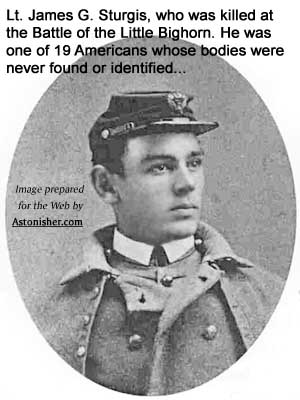|
||||||||||||
Bruce Brown's 100 Voices... John Sivertsen's Story of the Battle
THE STORY OF JOHN SIVERTSEN
"The fight in here was very hot and men were falling fast. We could not see the Indians, but they were signaling all the time to each other with their little bone whistles, and they seemed to be on all sides. [Note: the "little bone whistles" that Sivertson was refering to were called "eagle horns" by the Sioux, and were made form the leg bone of an eagle. Here is a sketch by David Humphreys Miller of Crazy Horse's Eagle Horn.] Major Reno got alarmed about the horses and ordered a retreat, but Capt. French changed the command to `Fall back with faces to the enemy!' I could find neither my horse nor the horse holder when this order to fall back to the river was given, and so, with about twelve or fourteen others, I stayed in the woods. Lieut. De Rudio was with us and took command. Firing was still going on all around us, and we could hear the shots and shouts in the pursuit of our comrades to the river and up the bluffs. We hid ourselves in the timber as best we might and succeeded in keeping out of sight of the Indians, but they kept on firing and were whistling all around us. Later, I can't tell how long afterward, things got quieter, and Lieut. De Rudio said we must try to get upon the bluffs to the command. So we crept down to the river. "It looked rather deep and as I was the tallest man there, I was ordered to cross first and show the way. Sergeant White, who was done out, asked me to take his gun, which I did, and waded the stream carrying two guns and two canteens. I got over all right and was the first to reach the other shore. A short distance up the hill I came across the body of an Indian. He was lying on his back with a carbine in one hand and a whip in the other. I felt his head and found that he had been scalped, so I suppose he was one of the Crow scouts that had joined us some days before, as none of our men had time to scalp a Sioux if they had killed one in their flight up the bluffs. The first man I met on top the bluffs was Captain French. He was very much astonished and pleased. They had had a roll call when they got on the bluff, and all who were not present were marked dead or missing. He shook my hand and said. "Fritz, I'm glad to see you. You are on the list of dead, and here you are back to life again. You're wet from fording the river. Go to the sergeant and get a blanket and sit down by the camp fire." So I found my troop, got a blanket and some food, partly dried my clothes, and got straightened out a little. The men knew nothing about Custer, but they had heard heavy firing after reaching the bluffs. I was put on the firing line. With my butcher knife I dug a little hole behind a sagebrush and fought from there. The bush wasn't two feet high and I was the biggest man in the troop, but somehow that bush seemed to be a protection. We were attacked many times that night and the next forenoon, but we held them off and once charged and drove them down the bank with a hurrah. The second day about noon, perhaps, we saw a body of men coming up the river valley. At first we thought it was more Indians, but as they came nearer we saw that they marched in order like soldiers, and soon the cry arose, "It's Terry! It's Terry!" The few Indians that were still hanging around went off in a hurry, and in a little while Gen. Terry and his command were up on the bluffs beside us. He came forward and Reno's remnant formed a circle around him and his staff and gave him three cheers. The gray-haired commander took off his hat and wept like a child. Well, of course that ended the fighting there, and we were soon making friends with the relief party. And, one thing more: after we left the battle field and went into camp, I saw my horse out on the prairie and went and caught him. He was just as I had left him when I dismounted in the woods the first day of the fight. My blouse was still strapped across the saddle and the saddle pockets were filled with ammunition. Evidently the Indians had not got hold of him. I tell you I was glad to see him." The Custer Battle Book by Herbert Coffeen, A Reflection Book, Carlton Press, Inc., New York, 1964 p 42 - 46
John Sivertsen resided in the National Soldier's Home, Washington, D.C., when Col. Hall interviewed him in 1915. Another survivor of of the Batlle of the Little Bighorn, James Wilber, was also in the Soldiers Home at the same time. This account of the battle originally appeared in The Teepee Book in 1916.
|
||||||||||||




 "AFTER WE HAD forded the Little Big Horn, above the Indian village," he says, "
"AFTER WE HAD forded the Little Big Horn, above the Indian village," he says, "







